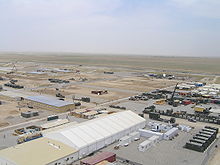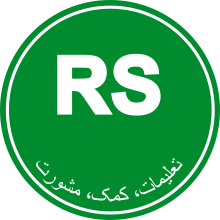Task Force Mazar-e Sharif
The operational squadron Mazar-e Sharif is a temporary unit of the German armed forces , which is stationed near the town of Mazar-e Sharif in Afghanistan as part of the Resolute Support mission .
history

The deployment of the Mazar-e Sharif squadron (EinsG MeS) took place on May 1, 2006. Before that, since November 3, 2005, a construction team, which consisted in particular of security forces , ordnance disposal personnel and air force pioneers, had mainly repaired the infrastructure and the flight operations areas. Initially, the squadron's task was to ensure air handling for passengers and cargo for the Bundeswehr and ISAF forces and to prepare the military part of the airfield for the relocation of the transport helicopters and planes from Termez to Mazar-e Sharif. Contrary to the original plan, after the Bundestag resolution of March 9, 2007, only six reconnaissance tornadoes were stationed on April 5, 2007 , and the relocation of the transporters was postponed. With the arrival of the tornadoes, the squadron had its first aircraft and, in addition to logistical support for the operations in Afghanistan, a new order, air reconnaissance on behalf of the ISAF headquarters in Kabul .
On November 1, 2007, six Sikorsky CH-53-GS helicopters and in August 2008 eight Transall C-160s were relocated from Termez in Uzbekistan to Mazar-e Sharif. With the use of unmanned Heron 1 aircraft from March 2010, the squadron had its largest size. With the turn of the year 2014/2015, the squadron now supports the ISAF successor mission Resolute Support.
Organization and mandate
The operational squadron Mazar-e Sharif is made up of personnel and material from several branches of the armed forces and military organizational areas and was a novelty in the history of the Bundeswehr with its temporary mixture of transport and combat aircraft and unmanned aerial vehicles. Nationally it is subordinate to the operational command of the Bundeswehr in Potsdam and is led by a commodore in the rank of colonel , who is supported by a staff. The squadron is divided into a task force, a task support group and an object protection group, each of which is led by a commander with the rank of lieutenant colonel .
Task Force
The tasks of the task force are basically comparable to those of a flying group of a German squadron. The core task is the planning and implementation of operational assignments. In the area of tornadoes, this included operational planning and implementation of reconnaissance flights and subsequent evaluation of the films and images. An evaluation system (Recce Ground Station) was available for the aerial photograph evaluation staff , which made it possible to provide the respective client with initial results via the ISAF headquarters within a very short time.
The unmanned Heron 1 are guided from a ground station, the so-called Advanced Ground Control Station (AGCS), by a pilot, the Air Vehicle Operator (AVO), and the sensor operator, the Payload Operator (PO). The unmanned aerial vehicles transmit images and films in real time to the units on site in the operational area.
Until the end of 2014, the order for the CH-53 GS and C-160 primarily comprised ensuring the MedEvac capability around the clock with two CH-53 GS helicopters and a Transall C-160, since then exclusively with the CH-53. In addition, personnel and material are transported. To support flight operations, the Air Force's operations command service offers the air surveillance radar (LÜR), a radar-supported flight information service for arrivals and departures . Together with Afghan air traffic control personnel , air traffic controllers coordinate and monitor flight operations at the airfield and within the control zone .
Mission support group
The tasks of the operational support group include logistics , including the use of vehicles and the handling of military passengers and cargo, and aircraft technology with the maintenance and repair of the respective weapon systems. In order to create the best possible conditions for this, three hangars were newly built, which are air-conditioned and largely protected from the ingress of desert dust by a slight overpressure inside.
Object protection group
The object protection group, which is mainly composed of personnel from the Air Force object protection regiment , is responsible for securing Camp Marmal and repelling attacks. For this purpose, in addition to guarding, patrols are also carried out in the vicinity of the airfield. Support is provided by a Croatian infantry platoon. In addition, the property protection group provides the fire fighters for fire protection , airfield damage clearance / runway rapid repairs and forces for explosive ordnance detection and removal.
Termez strategic air transport base
The Air Force only uses aircraft with self-protection equipment for flights to Afghanistan. In Termez, Uzbekistan, around 110 soldiers operate the Termez strategic air transport base (Strat LTStp Termez) for air cargo handling and passenger handling after aircraft landings from Germany ( e.g. A310 ) and the subsequent onward flight with C-160 Transall or possibly with CH-53 to Afghanistan. . This emerged from the Termez squadron, which was dissolved on August 31, 2008.
Aircraft
The Mazar-e Sharif squadron operates unmanned Heron 1 aircraft and CH-53 GS helicopters . Six reconnaissance tornadoes that were used from 2007 onwards were withdrawn on November 27, 2010. From December 2012 to mid-2014, four Tiger support helicopters were relocated to Mazar-e Sharif. NH-90 helicopters were also used for a short time. At the end of 2014, the remaining C-160s were separated from the association and relocated to Germany.
In June 2020 the CH-53 flew 22,222. Flying lesson in action.
Mazar-e Sharif airport
Mazar-e Sharif Airport is located southeast of the city. It is a civil airfield operated by the Afghan Ministry of Transport and used by RS forces as part of their mandate.
Legal basis
The use of German armed forces is based on resolutions 1386 (2001), 1413 (2002), 1444 (2002), 1510 (2003), 1563 (2004), 1623 (2005) and 1707 (2006) of the United Nations Security Council . The current mandate of the Bundeswehr's ISAF mission, as resolved by the Bundestag, ended on December 31, 2014.
Web links
- Herbert Albring: "Enlightenment - eyes on Afghanistan" in: Y. - Magazine of the Bundeswehr online, November 5, 2007
- The operational wing Mazar-e Sharif on the Air Force homepage
Individual evidence
- ↑ Application of the Federal Government: "Participation of armed German forces in the deployment of an international security support force in Afghanistan under the leadership of NATO ..." of February 8, 2007 (PDF; 69 kB)
- ^ "Bundestag sends tornadoes to Afghanistan", FAZ.net, March 9, 2007; accessed on January 6, 2009
- ↑ Press release “Heron on the Approach” dated May 6, 2010 on the Air Force website ; accessed on November 29, 2010
- ↑ Bundestag printed paper 16/1759 of June 6, 2006 (PDF; 110 kB)
- ^ "Aufwuchs Einsatzgeschwader Mazar-e Sharif completed" on the Bundeswehr homepage; accessed on January 6, 2009
- ↑ Press release "Tornadoes have left Afghanistan" from November 27, 2010 on the Air Force website ; accessed on November 29, 2010
- ^ "Operation in Afghanistan, accessed on the Bundeswehr homepage" ; dated December 10, 2012



